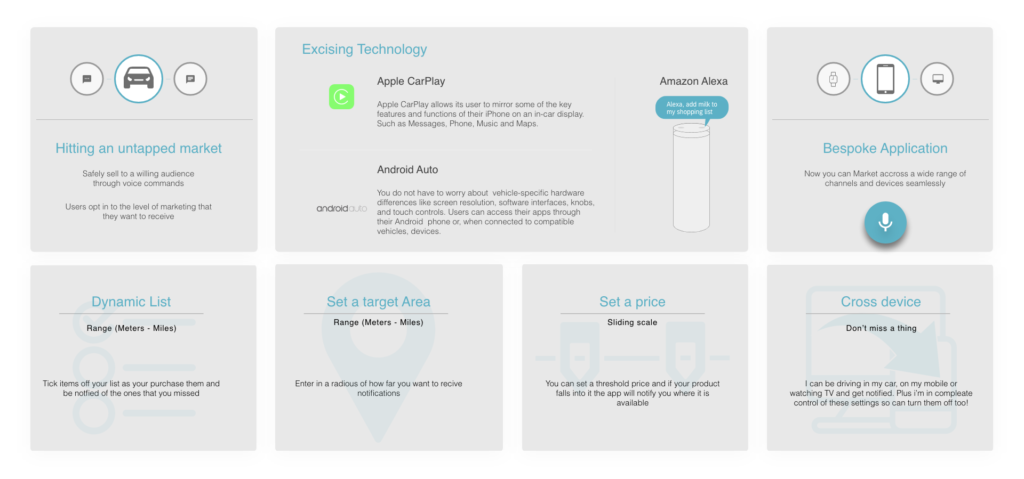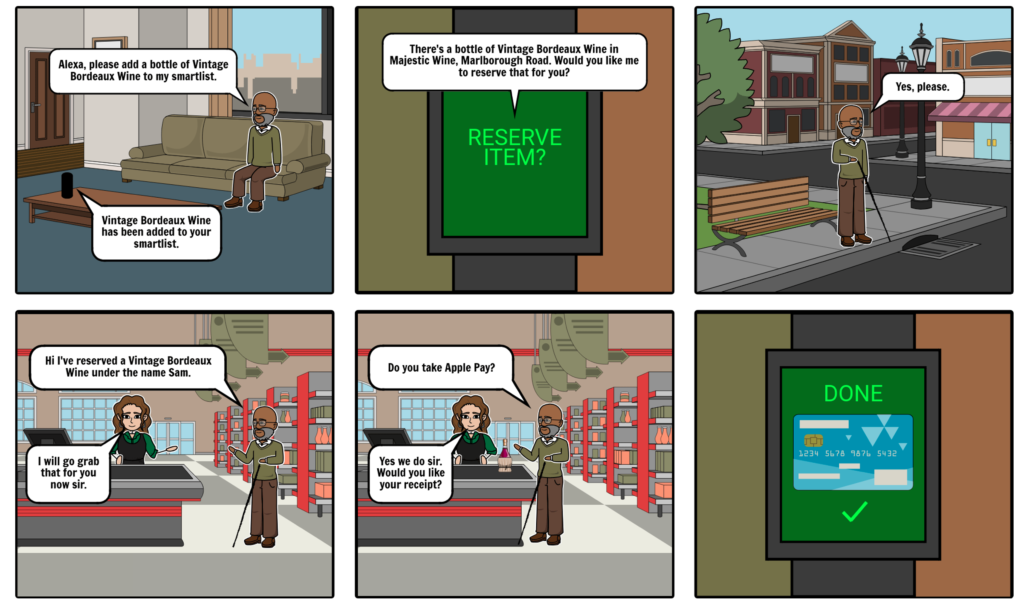Introduction
Being the design lead for Context Driven Services has put retargeting customers at the forefront of my mind. I wanted to explore a new safe way of retargeting consumers.
Recently sales figures have dropped drastically for brick and mortar and retailers are desperate to get customers back into stores. Statistics at Christmas 2020 revealed that for every three pounds being spent online on one pound was spent in stores. So this was another problem we wanted to tackle in this project.
As a UXer accessibility plays a very important role in my designs I make them as inclusive as possible and wanted that to play a large part in the project.
The need
Do you, the reader ever forget to purchase the items you need?
We surveyed 2000 adults nation-wide and on average they forget about 3 things a day.
So what are the top things three people forget when it comes to shopping?
One of them is milk, the other is a birthday presents and finally it was why did I go to the shop in the first place! So what does that mean for our customers (retailers)? Less revenue, as you can’t spend money on something you have forgotten to buy!
What if consumers could tell our software, what it was that they wanted to purchase and then just forget about it?
We would check every participating store based on their GPS location. So, wherever they may be, relentlessly items are being searched for their availability. We would also match the search criteria according your previous trips, so you do not have to make a dedicated journey to collect the item. This will appeal to customers wanting to reduce their carbon footprint. Once we find a match to their search criteria, we will notify them with a message, so they never need to miss out on the available products they want around them.
I will give you a real-life example of a scenario where it could have been useful:
The Smart List
Last Saturday I was driving up to Rugby (which is pretty far from me and a bit out in the sticks) we were going there to celebrate my little brother in law’s birthday. Unfortunately, both my wife Anna & I completely forgot to buy his present. We knew he has wanted a ‘Nintendo Switch’ for some time, so no excuse really! By the time we arrived at the family home all of the shops the local shops were closing. We did not have time to travel to the next village and an online order would arrive too late.
1. This is Jago he is entering the present into his ‘Smartlist’
2. One week later Anna & Jago prepare to travel up to Rugby for the birthday party
3. They are on their route and the smart list notifies them that one of the products they want is available. It also offers to reserve the item.
4. Then it notifies them about the gps update. A three minute increase in this case.
5. They arrive in the store and ask the staff member to get the reserved item
6-7. Whilst the staff member goes to collect, Jago & Anna browse. They notice another item and purchase it together.
8. They complete their purchase and continue on their journey
This user case shows how our application could have helped Anna and myself avoid an awkward situation and purchase the present one time. As we could have collected the console on one of their existing routes and did not have to make a special trip it also demonstrates a possible reduction in their carbon footprint and shows how it could have also saved time.
For the retailer, we have successfully recovered what could have been lost revenue. Getting customers who were ready to purchase into the store has resulted in both a sale and an upsell.
High-ticket items
I have another scenario I would like to take you through. ‘A wish list’ of high-ticket items.
 So, things that you want to buy maybe cannot justify paying full price for. The consumer can enter them into our smart list and as they travel around, we will make calls to all participating stores APIs within the set radius. Checking the products availability and cross-referencing it with the users search criteria such as price which is useful as this mulberry bag is over 1k. So not easy to justify as it is pretty expensive, and they already has quite a few already. But if we notify the them that it has substantially dropped in price due to a flash sale then this should be enough to tip them towards purchasing the item.
So, things that you want to buy maybe cannot justify paying full price for. The consumer can enter them into our smart list and as they travel around, we will make calls to all participating stores APIs within the set radius. Checking the products availability and cross-referencing it with the users search criteria such as price which is useful as this mulberry bag is over 1k. So not easy to justify as it is pretty expensive, and they already has quite a few already. But if we notify the them that it has substantially dropped in price due to a flash sale then this should be enough to tip them towards purchasing the item.
The problem I find with an online search is that you are only searching the products price in that moment. As we all know prices can fluctuate. Our application will continue to search for you and let you know when the item is available within a price threshold of your choosing.
Our platform can help bring customers back into stores and help them recover from the recent rise of internet sales and help them compete by converting potential online customers (e.g. Amazon) to bricks and mortar ones. Having customers back in the shops will allow retailers to upsell to them; this could be with points of sale or well trained staff.
Accessibility
I will show you another user-case. This time how we could assist somebody with a visual impairment.
1. Sam is visiting a friend and wanted to bring a bottle of wine. He added one to his smart list on his route to Bills.
2. He starts his journey and is then notified about a suitable bottle on his route. The application asks if he would like his order to be reserved.
3. He agrees
4. Sam then goes into the store to collects it.
5-6. Sam pays with apple pay and continues on his journey.
Our application gives the user more independence to shop for the items they want on the routes they know.
The store has received a request for an exact item, so this clears up ambiguity in verbal communication from Sam and the store.
Implementation
So I have just explained the concept. Here are what I think are the 3 main implementation issues:
1 – Stores need to make their APIs open to us
2 – We would need a large amount of participate customers to make the platform a complete success
3 – Consumers would have to use an application
We don’t think they are insurmountable, but we are aware that they do need to be addressed.
Machine learning
In store purchases: Half of the 73 people we surveyed had recently made a purchase in store.
Reasons they cited for choosing this option were:
- Immediacy
- No need to pay delivery charges
- Easier to return if needed, and also less likely to need returning as they can vet the item before purchase
All of which online eCommerce cannot replace.
When shopping online people are much more price driven, however finding the best price comes at a cost- 40% of those sampled said they did NOT enjoy the process of researching about a product and price before making a purchase.
“I wouldn’t say I enjoy it, it’s dull and time consuming”
“I prefer detailed info to be readily available and I hate the time it takes, swimming through hundreds of different answers on message boards”
All people also make impulse purchases when out and about; perhaps they are reminded about something they needed or an item simply catches their eye that they had no thought about before.
To date, no one has decoded exactly how, when and why the modern consumers makes a purchase.
From a recent IBM report, shopping experiences can be leveraged with much more AI in the background. Today only 2% of online shoppers make a purchase on their first visit to an e-commerce site. Ad retargeting has therefore become commonplace, a technique to recoup the remaining 98% of potential customers. While lucrative in some aspects, this can be incredibly annoying; many consumers do not respond to retargeted ads because they immediately identify the advertiser’s strategy.
If it seems like every tech company is slinging around buzzwords like “big data,” “artificial intelligence,” and “machine learning,” well, you’re not wrong. The thing is companies have a lot of data at their fingertips. But making use of that data is a challenge.
Machine learning is able to make sense of digital data at a much faster rate than any human is capable of. But what will make the largest impact?
1. Segmentation, Personalisation, & Targeting – When offline shoppers have a question, concern, or hesitation, a salesperson is there to give them the right information to nudge them closer to purchase. Online, we have trouble understanding the vast amounts of data needed to be able to provide the same tailored experience; which means it’s very difficult to nudge an on-the-fence shopper closer to purchase.
This is where machine learning makes an impact. Machine learning technology makes it possible to provide optimised experiences that drive sales and increase revenue.
It’s powerful to run super targeted campaigns that push customers down the conversion funnel.
2. Pricing Optimisation: Pricing is important. You can’t just rely on a set markup rate or even the local market price to win the sale.
Machine learning technology can change prices to account for many factors at once. Your competitors’ prices, demand, time of day, and type of customer could all influence your price. Machine learning technology makes it possible to adjust prices accordingly.
It’s powerful to have dynamic pricing that wins the sales every time.
3. Search Ranking – If your shoppers can’t find what they’re looking for, they won’t be able to buy it.
Factors like content, preferences, and similar items all play into providing the optimal search results. Machine learning is able to pull information from deep within the patterns of search and purchases—rather than just keywords.
It’s powerful to show your customers exactly what they want.
4. Product Recommendations – Amazon has proven that product recommendations work. Their Recommendation Engine is responsible for 35% of its sales. But it takes a lot of computing power to find the right patterns in product sales and shopping behaviour.
Machine learning can do it. It is possible for an intelligent employee to write “if this, then that” rules, but this limits recommendations to only reflect the employee’s knowledge. Machine learning can effortlessly quantify buying behaviour over and over again, each time digging deeper into trends.
It’s powerful to recommend what your customers didn’t know they wanted.
5. Supply & Demand Prediction – Forecasting is common enough. But today, with more data than ever before, companies are choosing to leave this task to the machines. Not only is machine learning able to process data faster, it’s also able to find unique insights hidden where people weren’t thinking to look.
And forecasting is just the tip of the iceberg when it comes to business intelligence. Machine learning can be applied to a number of analytical goals. With deeper, more accurate information, companies can make data-backed decisions that ultimately lead to better products and services.
It’s powerful to make better business decisions.



